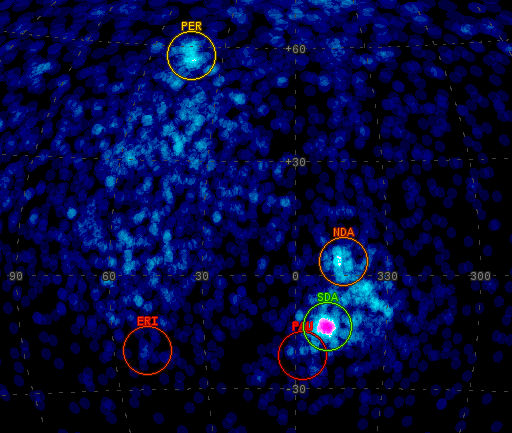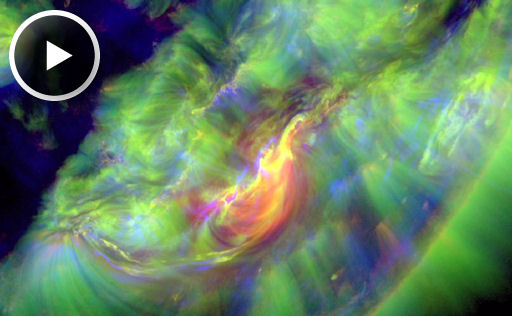THE PERSEID METEOR SHOWER IS UNDERWAY: Earth is passing through a stream of debris from Comet Swift-Tuttle, source of the annual Perseid meteor shower. Worldwide observers are now reporting more than 90 Perseids per hour. Forecasters recommend looking during the dark hours before dawn, especially Sunday morning, August 12th, when activity is expected to be highest.
Realtime Perseid Photo Gallery
Got clouds? Tune into SpaceWeather Radio for live echoes from Perseid meteors flying over the US Space Surveillance Radar in Texas.
The multi-station Canadian Meteor Orbit Radar, sponsored by NASA's Meteoroid Environment Office, is also monitoring the Perseids. Live data are available here. Bright spots in this sample radar sky map show the radiants of currently active showers:
Clearly, the Perseids are not the only meteors in the sky this weekend. The Northern and Southern Delta Aquarids (NDA and SDA) are also active. These showers, which are minor compared to the Perseids, spring from 96P/Machholz, a comet that some researchers suspect is a visitor from another star system.
This is a great weekend for watching meteors--but that's not all. Venus, Jupiter and the crescent Moon are lining up in the pre-dawn sky right in the middle of the Perseid display. The conjunction of planets guarantees that you will see something beautiful even in the unlikely event that the shower fizzles. Sky maps: Aug. 11, 12, 13.
Realtime Perseid Photo Gallery
M-CLASS SOLAR FLARE: Sunspot AR1540 erupted on August 11th, producing a long-duration M1-class solar flare that peaked around 1220 UT. NASA's Solar Dynamics Observatory recorded the extreme ultraviolet flash:
The explosion hurled a faint cloud of plasma into space. Judging from the blast site's off-center location on the solar disk, the cloud is probably not heading for Earth. This conclusion is uncertain, however. Stay tuned for additional analysis. Solar Flare alerts: text, phone.

![]()
Solar wind
speed: 375.8 km/sec
density: 1.2 protons/cm3
explanation | more data
Updated: Today at 1626 UT
![]()
X-ray Solar Flares
6-hr max: B8 1334 UT Aug12
24-hr: B8 1334 UT Aug12
explanation | more data
Updated: Today at: 1600 UT
![]()
![]()
![]()
Daily Sun: 11 Aug 12
![]()
![]()
Solar activity is mostly low. Sunspot 1542 continues to crackle with minor C-class solar flares. Credit: SDO/HMI
![]()
![]()
![]()
Sunspot number: 98
What is the sunspot number?
Updated 10 Aug 2012
Spotless Days
Current Stretch: 0 days
2012 total: 0 days (0%)
2011 total: 2 days (<1%)
2010 total: 51 days (14%)
2009 total: 260 days (71%)
Since 2004: 821 days
Typical Solar Min: 486 days
Update10 Aug 2012
The Radio Sun
10.7 cm flux: 131 sfu
explanation | more data
Updated 10 Aug 2012
![]()
![]()
![]()
Current Auroral Oval:
![]()
Switch to: Europe, USA, New Zealand, Antarctica
Credit: NOAA/POES
![]()
![]()
![]()
Planetary K-index
Now: Kp= 2 quiet
24-hr max: Kp= 2 quiet
explanation | more data
![]()
Interplanetary Mag. Field
Btotal: 5.7 nT
Bz: 2.6 nT north
explanation | more data
Updated: Today at 1626 UT
![]()
![]()
![]()
Coronal Holes: 11 Aug 12
![]()
![]()
There are no large coronal holes on the Earthside of the sun. Credit: SDO/AIA.






